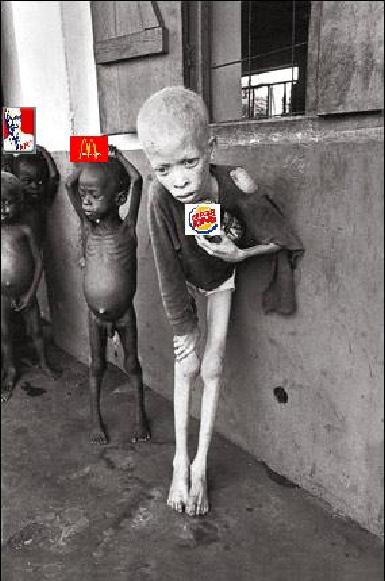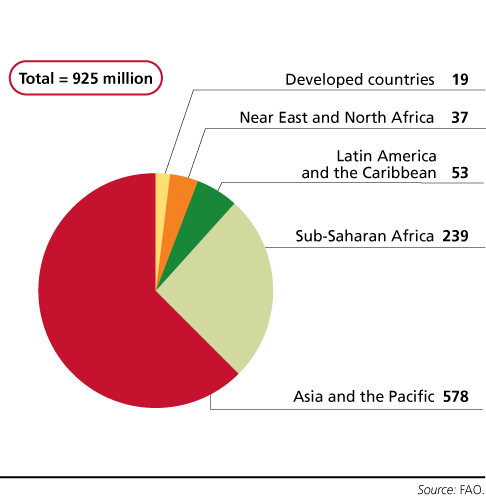image by (c) puertoboricua 2009
Hunger is a term which has three meanings (Oxford English Dictionary 1971)
- the uneasy or painful sensation caused by want of food; craving appetite. Also the exhausted condition caused by want of food
- the want or scarcity of food in a country
- a strong desire or craving
Malnutrition is a general term that indicates a lack of some or all nutritional elements necessary for human health (Medline Plus Medical Encyclopedia).
There are two basic types of malnutrition. The first and most important is protein-energy malnutrition--the lack of enough protein (from meat and other sources) and food that provides energy (measured in calories) which all of the basic food groups provide. This is the type of malnutrition that is referred to when world hunger is discussed. The second type of malnutrition, also very important, is micronutrient (vitamin and mineral) deficiency. This is not the type of malnutrition that is referred to when world hunger is discussed, though it is certainly very important.
Recently there has also been a move to include obesity as a third form of malnutrition. Considering obesity as malnutrition expands the previous usual meaning of the term which referred to poor nutrition due to lack of food inputs.2 It is poor nutrition, but it is certainly not typically due to a lack of calories, but rather too many (although poor food choices, often due to poverty, are part of the problem). Obesity will not be considered here, although obesity is certainly a health problem and is increasingly considered as a type of malnutrition.]
Protein-energy malnutrition (PEM) is the most lethal form of malnutrition/hunger. It is basically a lack of calories and protein. Food is converted into energy by humans, and the energy contained in food is measured by calories. Protein is necessary for key body functions including provision of essential amino acids and development and maintenance of muscles.
(image by (c)puertoboricua2009)
No one really knows how many people are malnourished. The statistic most frequently cited is that of the United Nations Food and Agriculture Organization, which measures 'undernutrition'. The FAO did not publish an estimate in its most recent publication, 'The State of Food Insecurity in the World 2011' as it is undertaking a major revision of how it estimates food insecurity (FAO 2011 p. 10). The 2010 estimate, the most recent, says that 925 million people were undernourished in 2010 (FAO 2010). As the figure below shows, the number of hungry people has increased since 1995-97. The increase has been due to three factors: 1) neglect of agriculture relevant to very poor people by governments and international agencies; 2) the current worldwide economic crisis, and 3) the significant increase of food prices in the last several years which has been devastating to those with only a few dollars a day to spend. 925 million people is 13.6 percent of the estimated world population of 6.8 billion. Nearly all of the undernourished are in developing countries.
Number of hungry people, 1969-2010

Source: FAO
In round numbers there are 7 billion people in the world. Thus, with an
estimated 925 million hungry people in the world, 13.1
percent, or almost 1 in 7 people are hungry. 
Source: FAO
The FAO estimate is based on statistical aggregates. The FAO first estimates the total food supply of a country and derives the average per capita daily food intake from that. The distribution of average food intake for people in the country is then estimated from surveys measuring food expenditure. Using this information, and minimum food energy requirements, FAO estimates how many people are likely to receive such a low level of food intake that they are undernourished.3
Undernutrition is a relatively new concept, but is increasingly used. It should be taken as similar to malnutrition. (It should be said as an aside, that the idea of undernourishment, its relationship to malnutrition, and the reasons for its emergence as a concept is not clear to Hunger Notes.)
Children are the most visible victims of undernutrition. Children who are poorly nourished suffer up to 160 days of illness each year. Poor nutrition plays a role in at least half of the 10.9 million child deaths each year--five million deaths. Undernutrition magnifies the effect of every disease, including measles and malaria. The estimated proportions of deaths in which undernutrition is an underlying cause are roughly similar for diarrhea (61%), malaria (57%), pneumonia (52%), and measles (45%) (Black 2003, Bryce 2005). Malnutrition can also be caused by diseases, such as the diseases that cause diarrhea, by reducing the body's ability to convert food into usable nutrients.
According to the most recent estimate that Hunger Notes could find, malnutrition, as measured by stunting, affects 32.5 percent of children in developing countries--one of three (de Onis 2000). Geographically, more than 70 percent of malnourished children live in Asia, 26 percent in Africa and 4 percent in Latin America and the Caribbean. In many cases, their plight began even before birth with a malnourished mother. Under-nutrition among pregnant women in developing countries leads to 1 out of 6 infants born with low birth weight. This is not only a risk factor for neonatal deaths, but also causes learning disabilities, mental, retardation, poor health, blindness and premature death.



No comments :
Post a Comment
Please comment about anything concern to your own perspective.